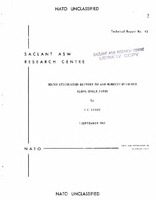Sound attenuation between 200 and 10,000 cps measured along single paths
| dc.contributor.author | Leroy, Claude C. | |
| dc.date.accessioned | 2018-10-11T14:07:33Z | |
| dc.date.available | 2018-10-11T14:07:33Z | |
| dc.date.issued | 1965/09 | |
| dc.identifier | 2353 | |
| dc.identifier.govdoc | TR-43 | |
| dc.identifier.uri | http://hdl.handle.net/20.500.12489/341 | |
| dc.description.abstract | In the deep Mediterranean basins, the water is perfectly isothermal below 400 m, and the deep refracted ray gives clear signals up to 40 km, with a spreading loss free from any frequency-dependent effect. Exploiting this unique opportunity, a frequency analysis has been performed between 200 and 10,000 cps on the waveforms of acoustic signals from explosive sources, which had travelled along this path. Statistically, the change of spectrum with range is due only to absorption and internal spectral arrangements of the shock-wave energy. Seven independent acoustic runs were analyzed which led to similar results. The average gives a detailed accurate curve of relative attenuation between 500 and 8000 cps. | |
| dc.format | 58 p. : ill. | |
| dc.language | English | |
| dc.publisher | NATO. SACLANTCEN | |
| dc.relation.ispartofseries | AD0472615 | |
| dc.subject | Mediterranean Sea | |
| dc.subject | Acoustic propagation | |
| dc.subject | Underwater acoustics | |
| dc.subject | Explosive sound sources | |
| dc.subject | Deep water | |
| dc.subject | Sound attenuation | |
| dc.subject | Acoustic measurements | |
| dc.subject | Frequency measurements | |
| dc.subject | Ligurian Sea | |
| dc.subject | Balearic basin | |
| dc.title | Sound attenuation between 200 and 10,000 cps measured along single paths | |
| dc.type | Scientific Technical reports (TR) |
